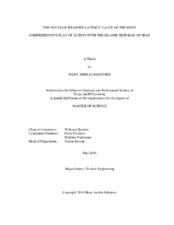| dc.description.abstract | The historic Joint Comprehensive Plan of Action (JCPOA) was implemented on January 16, 2016 between the Islamic Republic of Iran and the E3/EU+3. The JCPOA hopes to ensure that the nuclear program in Iran will exist solely for peaceful purposes. This agreement will end long-lasting and crippling sanctions enforced on Iran in exchange for inflexible reductions to the Iranian centrifuge enrichment program and assurances of the absence of efforts to develop, build, or acquire a nuclear weapon. Given Iran’s past actions of nuclear hedging and pushing the boundaries of agreements, policymakers would benefit from a reliable method to judge the effectiveness of this agreement and how it should influence future policy. One method that can help inform policy decisions is with estimates of a state’s Nuclear Weapon Latency. Nuclear Weapons Latency is defined as the time needed for a non-nuclear weapon state to develop a conventionally deliverable nuclear weapon.
Iran’s Nuclear Weapon Latency was quantified with and without the JCPOA using the Nuclear Weapons Latency Computational Tool developed by D. Sweeney and W. Charlton at Texas A&M University. This MATLAB-based software focuses on the use of time-dependent proliferation pathway modeling using Petri Nets. The proliferation pathways used in this analysis include mining, milling, conversion, enrichment (gas centrifuge and atomic vapor laser isotope separation), reactor repair or construction, fuel fabrication, plutonium production, PUREX reprocessing, development of delivery systems, and weapon systems. A reference time was developed for each transition within the pathway using the reported capacity or production of a facility when known or using the Pakistani nuclear program as a historic model if the characteristics for the Iranian facility are not known. The Petri Nets simulation provides an estimate of the distribution of likely time durations of a nuclear program until the first deliverable weapon is produced. The simulation can be analyzed to test for sensitivities due to the pathways and input parameters. This testing could be valuable in the development of policy and the identification of the key technologies that could most impact Iran’s Nuclear Weapons Latency. The analysis performed here shows that the large reduction in the stockpile of nuclear material and enrichment capability caused a sizable increase in the Iranian Nuclear Weapons Latency. | en |


